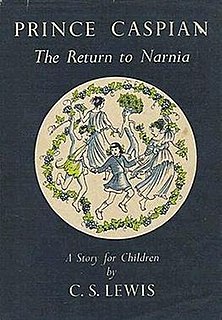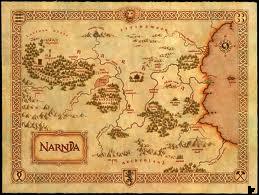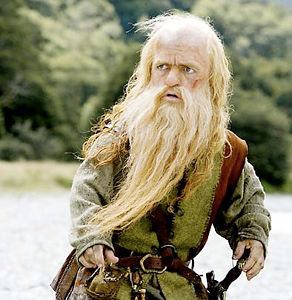
Prince Caspian is a high fantasy novel for children by C. S. Lewis, published by Geoffrey Bles in 1951. It was the second published of seven novels in The Chronicles of Narnia (1950–1956), and Lewis had finished writing it in 1949, before the first book was out. It is volume four in recent editions of the series, sequenced according to the internal chronology of the books. Like the others, it was illustrated by Pauline Baynes and her work has been retained in many later editions.

Narnia is a fantasy world created by C. S. Lewis as the primary location for his series of seven fantasy novels for children, The Chronicles of Narnia. The world is so called after the country of Narnia, in which much of the action of the Chronicles takes place.

Peter Pevensie is a fictional character in C. S. Lewis's The Chronicles of Narnia book series. Peter appears in three of the seven books; as a child and a principal character in The Lion, the Witch and the Wardrobe and Prince Caspian, and as an adult in The Last Battle. He is only mentioned in The Horse and His Boy in which he is away on the northern frontier fighting giants and in The Voyage of the Dawn Treader in which he is studying under the tutelage of Professor Kirke.

Edmund "Ed" Pevensie is a fictional character in C. S. Lewis's The Chronicles of Narnia series. He is a principal character in three of the seven books, and a lesser character in two others.

The Telmarines are a people in the fictional world of Narnia created by the British author C. S. Lewis for his series The Chronicles of Narnia. Hailing from Telmar, the Telmarines are prominent in the book Prince Caspian, the second book published in the series. The Telmarines were pirates in our world before entering the Narnian world through a magical cave.

Prince Caspian is a fictional character in The Chronicles of Narnia by C. S. Lewis. He is featured in three books in the series: Prince Caspian, The Voyage of the Dawn Treader, and The Silver Chair. He also appears at the end of The Last Battle.

The Chronicles of Narnia: Prince Caspian is a 2008 high fantasy film co-written and directed by Andrew Adamson, based on Prince Caspian, the second published, fourth chronological novel in C. S. Lewis's epic fantasy series, The Chronicles of Narnia. It is the second in The Chronicles of Narnia film series from Walden Media, following The Chronicles of Narnia: The Lion, the Witch and the Wardrobe (2005). William Moseley, Anna Popplewell, Skandar Keynes, Georgie Henley, Liam Neeson, and Tilda Swinton reprise their roles from the first film, while new cast includes Ben Barnes, Sergio Castellitto, Peter Dinklage, Eddie Izzard, Warwick Davis, Ken Stott, and Vincent Grass. In the film, the four Pevensie children return to Narnia to aid Prince Caspian in his struggle with the "secret" help of Aslan for the throne against his corrupt uncle, King Miraz.

Miraz is a fictional character from C. S. Lewis's fantasy series The Chronicles of Narnia. He is the main antagonist in the book Prince Caspian, and is the uncle of the book's protagonist. Miraz is the false king of Narnia, having killed his brother, Caspian IX, in order to assume the throne just after the birth of his nephew. The relationship between Miraz and his brother's son, Prince Caspian, resembles that of Claudius and Hamlet in Shakespeare's play Hamlet, as well as Pelias and Jason from Greek mythology.

In C. S. Lewis's Chronicles of Narnia series of novels, Narnia is the country around which the books revolve. It is one of several lands in the Narnian world.
In C. S. Lewis's fantasy novel series the Chronicles of Narnia, the hill of the Stone Table, or Aslan's How, is a high mound or cairn south of the Great River in Narnia next to the Great Woods. The How was built over the hill of the Stone Table. The word how derives from the Old Norse haugr, meaning hill or mound. In parts of England, it is a synonym for barrow.

The First Battle of Beruna is a fictional battle in C. S. Lewis' fantasy series The Chronicles of Narnia. It is fought in Narnia at the edges of the Great River near the Fords of Beruna, in the year 1000 according to Lewis' Narnian timeline. It is the climactic battle of The Lion, The Witch and The Wardrobe and one of several battles in the Chronicles of Narnia.

The Chronicles of Narnia is a British BBC-produced television serial that was aired from 13 November 1988 to 23 December 1990 and is based on four books of C. S. Lewis's The Chronicles of Narnia series. The first series aired was The Lion, the Witch and the Wardrobe in 1988, the second series aired was Prince Caspian and The Voyage of the Dawn Treader in 1989 and the third series aired was The Silver Chair in 1990. This television serial was produced by Paul Stone and teleplayed by Alan Seymour. The Lion, the Witch, and the Wardrobe was directed by Marilyn Fox, while Prince Caspian, The Voyage of the Dawn Treader and The Silver Chair were directed by Alex Kirby.

Trumpkin is a fictional character in C. S. Lewis' fantasy novel series The Chronicles of Narnia. Trumpkin is an intensely practical and skeptical dwarf who lives during the reigns of King Miraz and King Caspian X. He is a major character in Prince Caspian, briefly mentioned in The Voyage of the Dawn Treader, and is a minor character in The Silver Chair.
The Seven Great Lords of Narnia are fictional characters in The Chronicles of Narnia by C. S. Lewis. They are briefly mentioned in Prince Caspian and are central to the plot in The Voyage of the Dawn Treader, the second and third published books, respectively, in the series.

The Chronicles of Narnia: Prince Caspian is an action-adventure video game developed by Traveller's Tales to coincide with the theatrical release of the film of the same name. The game was announced at E3 2007. It was released for the Nintendo DS, Xbox 360, PlayStation 2, Wii, Microsoft Windows and PlayStation 3 on 15 May 2008 in North America to mixed reception. The DS version was also the first game to implement Disney's DGamer online chat service.

Aslan is a major character in C. S. Lewis's The Chronicles of Narnia series. He is the only character to appear in all seven books of the series. C.S. Lewis often capitalises the word lion in reference to Aslan since he parallels Jesus Christ.
Prince Caspian/The Voyage of the Dawn Treader is the second series of The Chronicles of Narnia that ran from 1988 to 1990. The series, which was shown on BBC television in 1989, is an adaptation of two of C. S. Lewis's The Chronicles of Narnia novels: Prince Caspian and The Voyage of the Dawn Treader.
The following outline is provided as an overview of and topical guide to Narnia:











